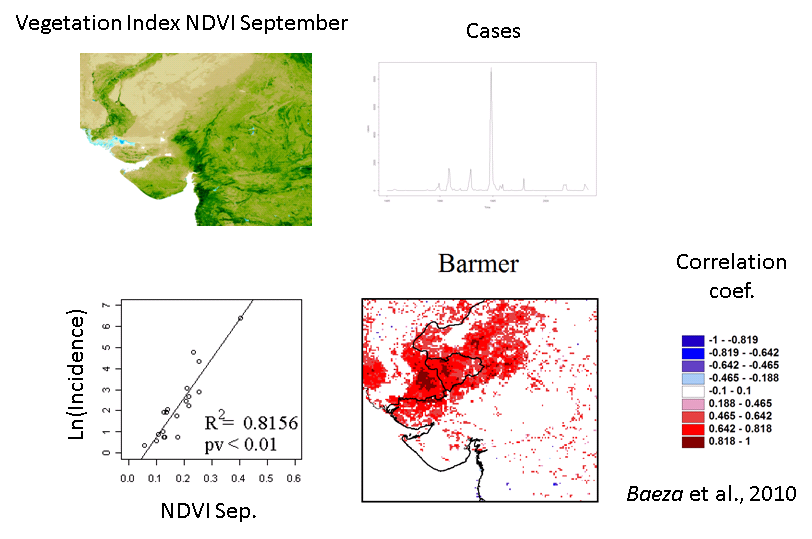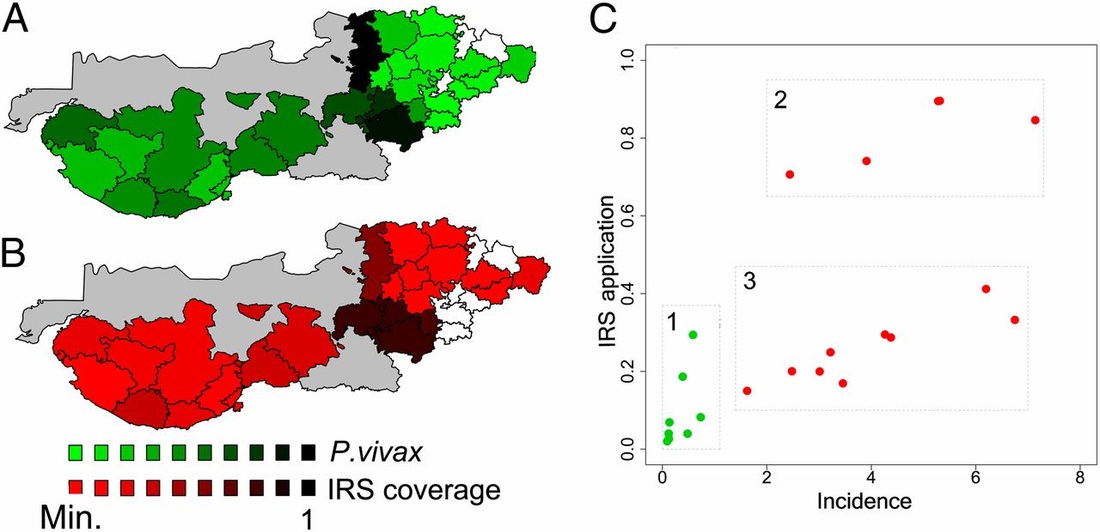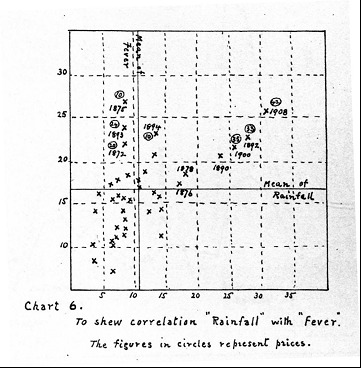Vegetation as a Climate Indicator: Modeling Malaria in the Punjab Region The devastation malaria has wrought on humanity cannot be overstated. On the wings of mosquitoes, this disease has long evaded eradication while preying disproportionately on our developing world. Malaria relentlessly suppresses societies in arid environments by exploiting the interplay of human behavior and ecological dynamics that drives poverty in these areas. Dr. Andres Baeza intimately understands the challenges to sustainability in these regions because he spent his formative years basking in the Chilean sun. Visiting from SESYNC, Dr. Baeza described to the Entomology department colloquium how he’s using his expertise to understand and empower disease intervention in the Northwest region of India. Dr. Baeza was quick to point out the precedent of his work in Gujarat and Rajasthan, India, with a graph (figure 1) representing fever (malaria) cases as they correlate with rainfall from a 1911 study by Sir Rickard Christophers. To modernize this idea, Dr. Baeza employed satellite images of vegetation (the normalized difference vegetation index or NDVI) to represent changes in the climate, such as rainfall. Here he is taking advantage of a simple concept: the same climate that would make local vegetation grow luscious and verdant would produce masses of ravenous mosquitoes. Dr. Baeza found that the NDVI correlates very well with epidemics in Northwest India (figure 2). In this same study, Dr. Baeza noted that areas with high irrigation were less sensitive to the effect that climate has on the number of malaria cases; the development of agricultural irrigation systems decouples the relationship between malaria risk and climate variability. 
Figure 2: Normalized difference vegetation index correlates with malaria cases in the Northwest India region (Baeza et al Malaria Journal 2011). Greener regions on the map indicate areas more growth of vegetation. As the correlation coefficient approaches 1, the vegetation index correlates more closely with cases of malaria. This figure shows that vegetation can be used to predict cases of malaria very well across the entire region.
Taking this further, Dr. Baeza used NDVI, malaria incidence, and insecticide spraying to show that, despite heavy insecticidal intervention, regions with recently introduced irrigation systems maintain a high risk for malaria. This essentially split the arid Gujarat region into 3 distinct regions (figure 3) with respect to their malaria risk: a high risk, un-irrigated region susceptible to climate forcing of epidemics (number 3 in part C of figure 3); a low risk region with long-established irrigation (number 1 in part C of figure 3); and a transitional, recently irrigated region with long lasting risk where insecticides are heavily applied (number 2 in part C of figure 3). 
Figure 3: Malaria (Plasmodium vivax) incidence in Gujarat region and insecticide spraying (inside residual spraying, IRS). The right side of the region has been irrigated for decades, and the band of high incidence is the advancing canal system. (Baeza et al PNAS 2013). Darker regions in the map in part A represent areas with higher incidence of malaria. Darker regions in the map in part B represent areas with more insecticide spraying.
Unsatisfied with idea of a long-lasting high-risk period, Dr. Baeza is now modeling NDVI and the many risk factors of the disease to suggest when and where to intervene- before malaria strikes. Currently, the region has a reactive mosquito control policy: when cases of malaria go up, insecticides are copiously applied. Under Dr. Baeza’s vision, when rainfall increases, insecticides can be applied to preemptively stop the impending mosquitoes. His modeling indicates that replacing the present reactive model of mosquito control with a rainfall model will save lives and free people of the burden malaria imposes. It also offers opportunities for guiding local participation in mosquito control. By directing when and how people can best lend a hand, a small amount of work can stop a devastating epidemic. Dusting off a century-old idea from Sir Christophers, Dr. Baeza and his collaborators are developing models for malaria epidemics in arid regions with a little help from modern technology. References Cited 1. Bio of Dr. Andres Baeza – http://www.sesync.org/users/abaezacastro 2. National Socio-Environmental Synthesis Center – http://www.sesync.org 3. Sir Rickard Christophers Obituary – http://www.mosquitocatalog.org/files/pdfs/MS11N01P055.pdf 4. NDVI Resource “Earth Explorer” – http://earthexplorer.usgs.gov/ Referenced Publications By Dr. Andres Baeza 1. Baeza, Andres, et al. "Climate forcing and desert malaria: the effect of irrigation." Malar J 10 (2011): 190. Link: http://www.pnas.org/content/110/37/15157.short 2. Baeza, Andres, et al. "Long-lasting transition toward sustainable elimination of desert malaria under irrigation development." Proceedings of the National Academy of Sciences 110.37 (2013): 15157-15162. Link: Brian Lovett is a PhD student studying mycology and genetics in agricultural and vector biology systems. He is currently working on projects analyzing mycorrhizal interactions in agricultural systems, the transcriptomics of malaria vector mosquitoes, and the genomes of entomopathogenic fungi.
Comments are closed.
|
Categories
All
Archives
June 2024
|
Department of Entomology
University of Maryland
4112 Plant Sciences Building
College Park, MD 20742-4454
USA
Telephone: 301.405.3911
Fax: 301.314.9290
University of Maryland
4112 Plant Sciences Building
College Park, MD 20742-4454
USA
Telephone: 301.405.3911
Fax: 301.314.9290


 RSS Feed
RSS Feed




